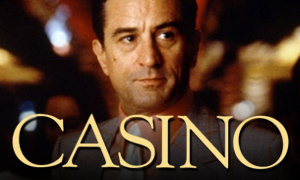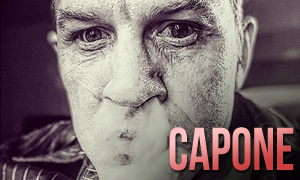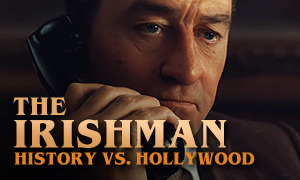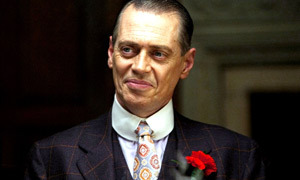Capone: History vs. Hollywood
| REEL FACE: | REAL FACE: |
Tom Hardy
Born: September 15, 1977 Birthplace: Hammersmith, London, England, UK | Al Capone
Born: January 17, 1899 Birthplace: New York City, USA Death: January 25, 1947, Palm Island, Florida, USA (cardiac arrest) |
Linda Cardellini
Born: June 25, 1975 Birthplace: Redwood City, California, USA | Mae Capone
Born: April 11, 1897 Birthplace: Brooklyn, New York, USA Death: April 16, 1986, Hollywood, Florida, USA |
Kyle MacLachlan
Born: February 22, 1959 Birthplace: Yakima, Washington, USA | Dr. Kenneth Phillips
Renamed Karlock in the Movie |
Matt Dillon
Born: February 18, 1964 Birthplace: New Rochelle, New York, USA | Johnny Torrio
Born: January 20, 1882 Birthplace: Montepeloso, Basilicata, Kingdom of Italy Death: April 16, 1957, New York City, USA (heart attack) |
Noel Fisher
Born: March 13, 1984 Birthplace: Vancouver, British Columbia, Canada | Albert Francis 'Sonny' Capone, Jr.
Born: December 4, 1918 Birthplace: Chicago, Illinois, USA Death: August 4, 2004, Florida, USA |
How long was Al Capone in prison before being released in 1939?
The Capone true story reveals that the former boss of the Chicago underworld served a total of seven years, six months and fifteen days of an 11-year prison sentence. He had been convicted of tax evasion in 1931 at age 32. He was first housed in the Cook County Jail and then the U.S. Penitentiary in Atlanta, before being transferred to Alcatraz in 1934. Like in the Capone Tom Hardy movie, he was released from prison due to his deteriorating health. After his release, he went to a Baltimore hospital for brain treatment and then to his home at 93 Palm Ave on Palm Island in Florida where he was looked after by his wife Mae Capone. While some believe that Al Capone faked dementia to get out of prison, we'll explain below why this theory is likely not accurate. -FBI.gov
Did Al Capone pay the government the fines and back taxes he owed?
Yes. Our Capone movie fact check confirms that by the time he was released from prison on November 16, 1939, Al Capone had paid his $50,000 fine and the $215,000 plus interest in back taxes he owed the government. He was also charged and paid $7,692 in court costs. -FBI.gov
Was Al Capone faking dementia?
The Capone movie's writer/director Josh Trank (Chronicle) isn't the first person to suggest that Al Capone's dementia might have been an act to get out of prison. Clyde Smaldone, who was the head of the Smaldone Family crime syndicate out of Denver, stated in author Dick Kreck's book Smaldone: The Untold Story of an American Crime Family, "They told Al he had syphilis and that's a damned lie. He never had syphilis. I think his heart was broken more than anything." Smaldone said that he went to see Capone a week before he died and that Capone did not exhibit signs of dementia.
However, the idea that Capone was faking his dementia seems far more fiction than fact. He had been diagnosed with gonorrhea and syphilis at the start of his 11-year prison sentence. He also went through withdrawal from a cocaine habit that had worn a hole in his septum. Dementia is one of the manifestations of late-stage syphilis after it has gone untreated and evolved into neurosyphilis. He had been formally diagnosed with neurosyphilis in February 1938. If the real Al Capone had indeed been suffering from untreated syphilis for many years, it makes sense that he would have been in cognitive decline and possibly experiencing hallucinations. Mass production of penicillin hadn't begun in the United States until 1942, and while he was one of the first patients to be treated with the new drug, it was too late to heal the damage to his brain. The Capone Tom Hardy movie uses his faltering mental state as a catalyst for his flashbacks to his days as a violent gangster.
Is Jack Lowden's character, FBI Agent Crawford, based on a real person?
As we investigated the Capone fact vs. fiction, we discovered that Jack Lowden's FBI Agent doesn't appear to be based on any single agent that monitored Capone in Florida. At best, he seems to be an amalgamation of the agents who surveyed Al Capone after his release from prison. Of course, the most famous agent to track Capone was the one who took him down, Prohibition Agent Eliot Ness, who was portrayed by Kevin Costner in the 1987 movie The Untouchables. Ness arrested Capone for tax evasion on June 5, 1931.
Did Al Capone really forget where he hid millions of dollars?
The Capone true story confirms that it has long been believed that Al Capone's fortune is out there somewhere and that he forgot where he hid it. The idea was introduced by his niece, Marie Capone, who wrote that her uncle had buried and hidden millions of dollars but was too mentally ill with dementia when he was released from prison to remember where it was at. At the height of his criminal empire, Chicago newspapers estimated Al Capone was making $100 million annually. His net worth was estimated to be roughly $1.3 billion in today's dollars. It makes sense that he would have hidden a large portion of his money, knowing he would need it when he got out of prison. People have been looking for his fortune unsuccessfully ever since his arrest.
It was rumored that he had buried the money on a peninsula in Michigan. However, in the 1980s, another theory came to light when a construction company was planning a renovation of the Lexington Hotel in Chicago. Prior to his imprisonment, Capone had lived in a suite at the hotel. The construction company found a series of escape tunnels beneath the hotel, along with a shooting range and most importantly, a secret vault. The tunnels led to nearby bars and brothels. As for the vault, its discovery resulted in many people believing that it contained at least part of Al Capone's money. The opening of the vault on April 21, 1986 became a nationally televised event hosted by Geraldo Rivera and viewed by more than 30 million people, making it the then-most-watched syndicated TV special of all time. Disappointingly, all that was found inside was a few empty bottles and dirt. The mystery surrounding the location of Al Capone's fortune remains unsolved.
How did Al Capone become a gangster?
All violent criminals get their start somewhere. Reportedly a bright student, Capone's well-known temper got the best of him when he was 14 and living with his family in New York City. A female teacher attempted to cane him and he punched her. As a result, he was expelled from school and never returned. After his parents moved to a new Brooklyn neighborhood, Capone found a sense of belonging when he joined two gangs, the Forty Thieves Juniors and the Brooklyn Rippers. Other members included future crime bosses Lucky Luciano and Johnny Torrio. Years later, when he was married to Mae and living in Brooklyn, Capone's crime boss, Frankie Yale, sent him to Chicago after he got in a fight with members of a rival crime family. In Chicago, Capone started working for Johnny Torrio (portrayed by Matt Dillon in the film). He took over in 1925 after Torrio was critically wounded in an assassination attempt and retired to Italy. Torrio eventually returned to the United States in 1928. As depicted in the Capone Tom Hardy movie, Al rose to the top by eliminating or muting rival gangs.
Where was Al Capone's Florida estate?
After he was released from prison and received treatment for late-stage syphilis at a Baltimore hospital, Al Capone went to his home in Florida, which he had purchased in 1928 for $40,000 (about $550,000 today). The estate is located at 93 Palm Ave on Palm Island in Biscayne Bay near Miami. While there, Al Capone's dementia and syphilis were managed with the help of his wife Mae Capone, his doctor Kenneth Phillips, and his staff. Prior to living at the Palm Ave estate after his release from prison, Al Capone had conveniently been there during the St. Valentine's Day Massacre in Chicago, which he is believed to have ordered. -FBI.gov
What are the details around The St. Valentine's Day Massacre?
One of Al Capone's biggest rivals in Chicago was Irish gangster George "Bugs" Moran. His gang had tried to assassinate Capone on September 20, 1926 while Capone was having lunch at the Hawthorne Hotel in Chicago. As bullets sprayed at him from Thompson sub-machine guns, his bodyguard saved him by tackling him to the floor and lying on top of him. Roughly two-and-a-half years later on Valentine's Day 1929, men disguised as police officers raided a garage where Moran ran his bootlegging empire from. They lined up seven of Moran's men against a wall and opened fire, killing all of the men (one was still alive when the actual police arrived but refused to talk before taking his last breath). The incident became known as The St. Valentine's Day Massacre. Moran pointed the finger at Capone, who was conveniently in Florida at his 93 Palm Ave estate at the time.
How did the real Al Capone get the nickname "Scarface"?
A Capone fact check reveals that the name "Scarface" comes from three scars Al Capone had as the result of an altercation in 1917. He had been working at a bar owned by mob boss Frankie Yale. A gangster named Frank Galluccio showed up at the bar one evening with his sister. Capone began to hit on Galluccio's sister and Galluccio stepped in and asked Capone to apologize. An altercation ensued and Galluccio pulled a knife out of his pocket and struck Capone in the face three times.
I thought the Al Capone Tom Hardy movie was called "Fonzo"?
"Fonzo" was the original title of the movie while it was in production. It is based on his nickname which comes from his full name, Alphonse Gabriel Capone.
Did Al Capone ever go back to Chicago in real life after his release from prison?
No. As depicted in the Tom Hardy movie, he never publicly returned to Chicago following his 1939 release from prison. He was no longer mentally capable of running a criminal empire. As depicted by Tom Hardy's character in the movie, Capone lived in seclusion on his Palm Island estate with his wife Mae Capone and immediate family.
How far had Al Capone's mental state deteriorated?
In his heyday, Capone was once named "Public Enemy No. 1." However, after he was examined by his physician Dr. Kenneth Phillips and a Baltimore psychiatrist in 1946, they both concluded that he had the mental capacity of a 12-year-old child. Al Capone's dementia from neurosyphilis had ravaged his brain and essentially de-aged him in terms of his mental capability. -FBI.gov
How did Al Capone die?
Like in the Capone movie, the true story confirms that the real Al Capone suffered a stroke on January 21, 1947. His condition began to improve but he contracted bronchopneumonia and went into cardiac arrest on January 22. He died in bed three days later on January 25, 1947 when his heart failed as a result of apoplexy. It was a week after his 48th birthday. Al Capone's death certificate is displayed below.







